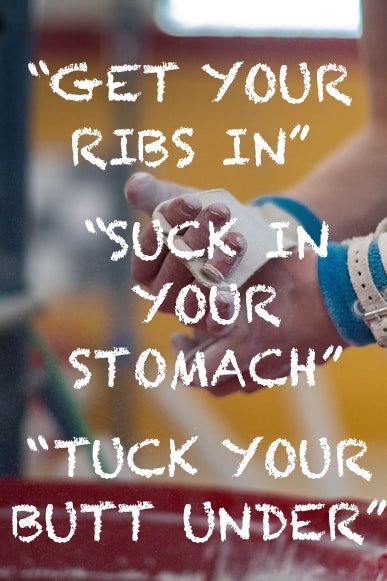“Thin to Win”
This blog will focus on one of the more aesthetic sports, and the experience of eating disorders within it. Some common aesthetic sports include gymnastics, ballet, diving, synchronized swimming, and figure skating. This blog will have focus on gymnastics, as it's the sport that I competed in college at the Division 1 level. I believe athletes of many appearance-driven sports will relate in some way to the information below. I also find it important for coaches, parents, and mental health professionals alike to gain insight into how a sport may breed an eating disorder.
Gymnastics
If you were to say any of those commands above, "Get your ribs in," "Suck in your stomach," or "Tuck your butt under," any ex-gymnast would most likely quiver from the memories. I would be shocked to find a high-level gymnastics coach who has never uttered these commands, no matter how nicely they may have been said. As a young gymnast, it's not uncommon to hear all three of these commands over 20 times a day. Of course, as the years go on, obtaining the correct shape is supposed to become second nature. However, it is very normal for coaches to correct shapes within routines at any age or skill level. The idea behind these commands is simple: make the straightest line possible with your body. Unfortunately, it's also desirable to get the thinnest line possible. These preferences also aren't present just because they are pleasing to the eye. You will actually lose tenths from your score if any of these standards are not met. Ribs are out on your handstand on bars? That'll be a tenth of a point deduction. Your bottom half isn't completely flat in your release move? There goes another tenth. It's not that you just want to achieve the thinnest, straightest line, it's that you have to.
So, what's the problem with this? It's easier to achieve this thin, straight line, the thinner that you are. Notice how the common command is to get your ribs in; what happens if you have a chest or breasts? Those must be tucked in too. Athletes who may already be worried about their weight, have other risk factors for developing an eating disorder, are perfectionistic in nature, have been told this command more than others, or feel that they're "heavy" within the sport, may attempt to change their body to better adhere to standards. The next concern here is that gymnasts dedicate their lives to their sport at a very young age, as it's not uncommon for 10-year-olds to spend 30+ hours a week in a gym.
While "normal" adolescents will go through puberty around 11-15 years of age, puberty in gymnasts often comes much later. High-level gymnasts may be in college before a menstrual cycle begins. This is often due to the intense hours and immense pressure the body and mind is under. In addition to this fact, delayed puberty is often celebrated in the culture in gymnastics. Young gymnasts are taught to fear puberty. They're taught to dread the day their breasts get larger or their body fat increases. The presence of a menstrual cycle often signifies the presence of body fat, breasts, and mood changes. All of the above are strictly frowned upon in the sport of gymnastics. Though the sport is changing, many of young gymnasts' idols growing up looked almost pre-pubescent in nature. They were often 5 feet tall or under, very thin, and lacking the markers of a womanly body. Why has the sport normalized a dread of the body's natural and healthiest state?
Culture
Aside from the rules and physiological desires within the sport, the culture itself probably plays one of the largest roles in why eating disorders come about within the sport. When I talk about gymnastics culture, I'm discussing the one within gymnasts, athletes, and the system as a whole. Recent lawsuits, documentaries, and gymnasts coming forward about different problems have started a change within the sport. However, not enough has been done.
Growing up in the USA Gymnastics system, you are taught many things, with many expectations placed upon you. You are meant to be tough, to never argue, to never cry, to take criticism, to be yelled at, to be kicked out, to be cussed out, and to always- say yes. It's normal for practices to incorporate punishment and reward systems from a young age. Did you fall on your beam routine? That means you must run for 20 minutes. Did you talk back to your coach? That will be 5 rope climbs. In some gyms, it may even look like: Did you mess up at your meet? Please limit your dinner. However, when you do something good, you get the long-awaited nod of approval. For that moment- you feel successful. You feel accomplished, and you crave that feeling from then on.
Another part of the culture that has been, and still is present, is that many, many gyms across the country will weigh their athletes daily. This goes from 7 year olds, to seniors in college depending on the program. To add to this, weighing is often done in the gym, in front of peers. That punishment and reward system referenced earlier absolutely applies here. Gymnasts who lose weight, are often praised, and given that desired stamp of approval. Those who remain the same, gain, or are still above where their coach would like them, often get a nice conditioning or cardio punishment. Only recently has the acceptability of training standards in the sport been questioned.
"Where Things Get Tricky.."
Here's where things get a little more complicated. Not only do judges want to see those "long pretty lines," but gymnastics may actually be easier the lighter that you are. However, this only lasts for so long. When a gymnast begins to lose weight, by altering their intake, increasing their exercise, or by engaging in other compensatory behaviors, their performance may actually improve. Skills may feel easier, their coach may compliment their shapes, and their scores may go up. Many gymnasts will experience this phenomenon and feel that they must be doing something right. However, this ease is initially coming because of a malnourished body.
What happens to a malnourished body? It tends to injure easily. This often then leads to some time away from the sport, which lessens exercise, which triggers one suffering from an eating disorder to monitor their intake even closer. It's a cycle that many gymnasts can sadly relate too. The next point that is also confusing is that gymnasts are, in fact, meant to be tough. There is nothing wrong with tough coaching. Sometimes, yelling may be used to motivate. Punishments and rewards may be used for good, or to instill drive in an athlete. Harsh comments may create a tougher individual, which lends to more success in the sport. Eating healthy may be the sign of a dedicated athlete. Someone who pays attention to their nutrition may simply just be trying to be the best athlete they can be.
This begs the question: where is the line?
Between athletic, and too thin
Between healthy, and disordered
Between dedicated, and overtrained
Between tough coaching, and abusive coaching
Between disordered eating, and an eating disorder
When It's a "Problem"
The last distinction is the one I will focus on. The answer is: it doesn't matter! Whether it's disordered eating or an eating disorder, it's still a problem. Sadly, this will be a controversial answer. When do I believe disordered eating becomes a problem? It's a problem when athletes prioritize their appearance over physical health, when they become obsessed with changing their body when they see their body through a distorted lens when they attempt to lose weight during a time period that they are meant to gain weight when they stop going to eat with their friends, when they limit what foods they are "allowed" to eat, and when they feel their stomach grumble during a practice. When do most people believe it's a problem?
A lot of gymnastics coaches will not see a problem with any of the above cases. If anything, they may praise this behavior. With this being said, some coaches (I was lucky to have a few of them) will see the problem with these ways. However, even many mental health professionals will not see a true problem at this stage. The problem is only present when criteria for an eating disorder has been met. This is the exact reason why disordered eating is seen as just "coming with the sport" or "normal" in gymnastics. Sadly, many gymnasts will go through their career not knowing they are engaging in disordered behaviors, not knowing they have an eating disorder, not knowing they deserve help, being congratulated for disordered behaviors, and believing they must be "thin to win." Only a "lucky" few will receive help.
What Can We Do?
Whether you are a coach, a parent, or a mental health professional, please don't overlook the presence and prevalence of eating disorders in gymnastics and other aesthetic sports. If you are a coach, notice, and care if an athlete appears to be getting weaker in the gym, or losing weight. If you are a parent, notice and know that no 12 year old should be placing themselves on a "diet." As a mental health professional, please screen your athletes for eating disorders. Don't wait for the injuries to occur. Don't wait for the criteria to be met. Don't wait for a life to be changed. Show them you care. Show them your support, and offer them help now. If you are an athlete reading this, and you relate in any way at all, know that I see you. I hear you, and I give you permission to fuel yourself, today and every day after. You deserve to live in not only a healthy body but a happy body. You deserve that "fear food," even if you have practice later. Even if you had a bad practice, you deserve your favorite dinner. Your sport is not your identity, and gymnastics is not forever. Allow yourself to grow within the sport, and NEVER let it try to shrink you.
About the Author
Thank you for taking the time to read this blog. My name is Maria Ortiz, and I'm currently a Licensed Mental Health Counselor specializing in eating disorders. I am also personally in recovery from an eating disorder. It is truly my passion to provide awareness, education, and therapeutic services regarding all things eating disorders. The road to recovery can be one of the most challenging processes one may ever face, and I'm grateful that my story led me to helping others find their hope again.



